7. Simplifying the deployment of your workstations¶
Many companies and administrations include software and configurations in the OS images they deploy on their fleets of hosts.
But from now on this is no longer the recommended method for several reasons:
Each time you make a new image, you waste a lot of time installing software and configuring it. You are very limited in the user configurations that you will be able to include in your image.
Each time you make a new image, you will have to keep track of the changes in a text document, a spreadsheet, or a change management tool.
OS editors (notably Microsoft) advise the use of raw ISO images and their parameterization in post-install.
Finally, if you introduce in your image security configurations, network configurations, or configurations to limit the intrusion of telemetry, these configurations can disrupt the normal functioning of WAPT, it will complicate future diagnostics.
With WAPT this is no longer necessary
7.1. Recommendations¶
Tranquil IT recommends:
To make only one raw image per OS type with MDT, Fog (win10, win2016, etc) or WAPT WADS without any configuration or software installation. Put only the system drivers you need for your image deployment in the MDT or Fog directories provided for this purpose.
To create as many Organizational Units as you have host types in the CN=Computers OU (ex: standard_laptop, hardened_laptop, workstations, servers, etc) in your Active Directory.
To configure your Active Directory to distribute the WAPT Agent by GPO to the different Host Organizational Units; this way, you can opt for fine grained configurations of your
waptagent.inifor the hosts attached to each OU.
Hint
To save you time, you can base your security configuration strategy on security WAPT packages already available in the WAPT Store, you will only need to complete them according to your Organization’s specific security requirements.
To create in the CN=Computers OU as many Organizational Units as there are types of computer usage in your organization (accounting, point_of_sale, engineering, sedentary_sales, etc).
To create generic WAPT packages of your software applications with their associated configurations.
7.1.1. Deployment scenario¶
You receive or the IT manager at the remote site receives a new computer in its box.
You configure the host’s MAC address in DHCP so that it gets the right system image and is positioned in the right Organizational Unit at the end of the deployment process.
The expected system image is downloaded on the host in masked time, the host is placed in the right Organizational Unit.
The WAPT Agent registers the host with the WAPT Server, it appears in the WAPT Console.
The WAPT Agent detects that it is in an Organizational Unit that requires a particular software set and a particular security configuration.
The WAPT Agent downloads and executes software packages and security configuration packages in hidden time; the WAPT Agent automatically removes delegated rights that are rendered useless after joining the domain to prevent them from being subsequently exploited in an unauthorized manner.
Either by group of hosts or host by host, you finalize the configuration of the hosts by assigning specific WAPT packets to them.
Hint
If you want, you can even leave the final configuration step to your users by configuring WAPT self-service for them (printer configurations, special software needs, etc).
7.2. Deploying your workstations via WADS  ¶
¶
WADS for WAPT Automated Deployment Services was developed to provide a simple solution for Operating System deployments via WAPT.
The OS Deployment is available for Windows, Debian and its derivates and for RedHat and its derivates.
7.2.1. WADS mode of operation¶
Schematically, deploying an OS involves 3 steps:
Importing the different media and files required for the deployment, such as Operating System .iso images, driver packs and configuration files.
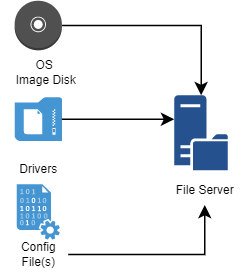
Flow diagram for importing the files required for the WADS deployment¶
Creating the boot support.
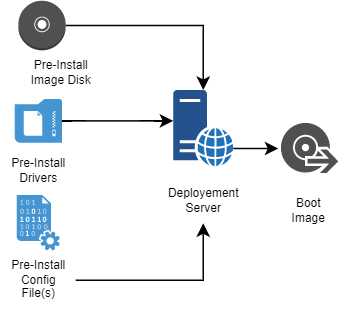
Flow diagram for creating the booting support for the WADS deployment¶
Launching the deployment on the target host using the network or a USB stick.
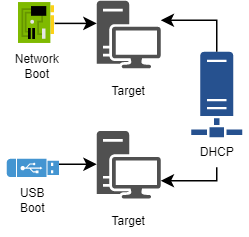
Flow diagram for using the boot support in the WADS deployment¶
7.2.2. Difference between WADS and other solutions¶
Classic deployment solution.
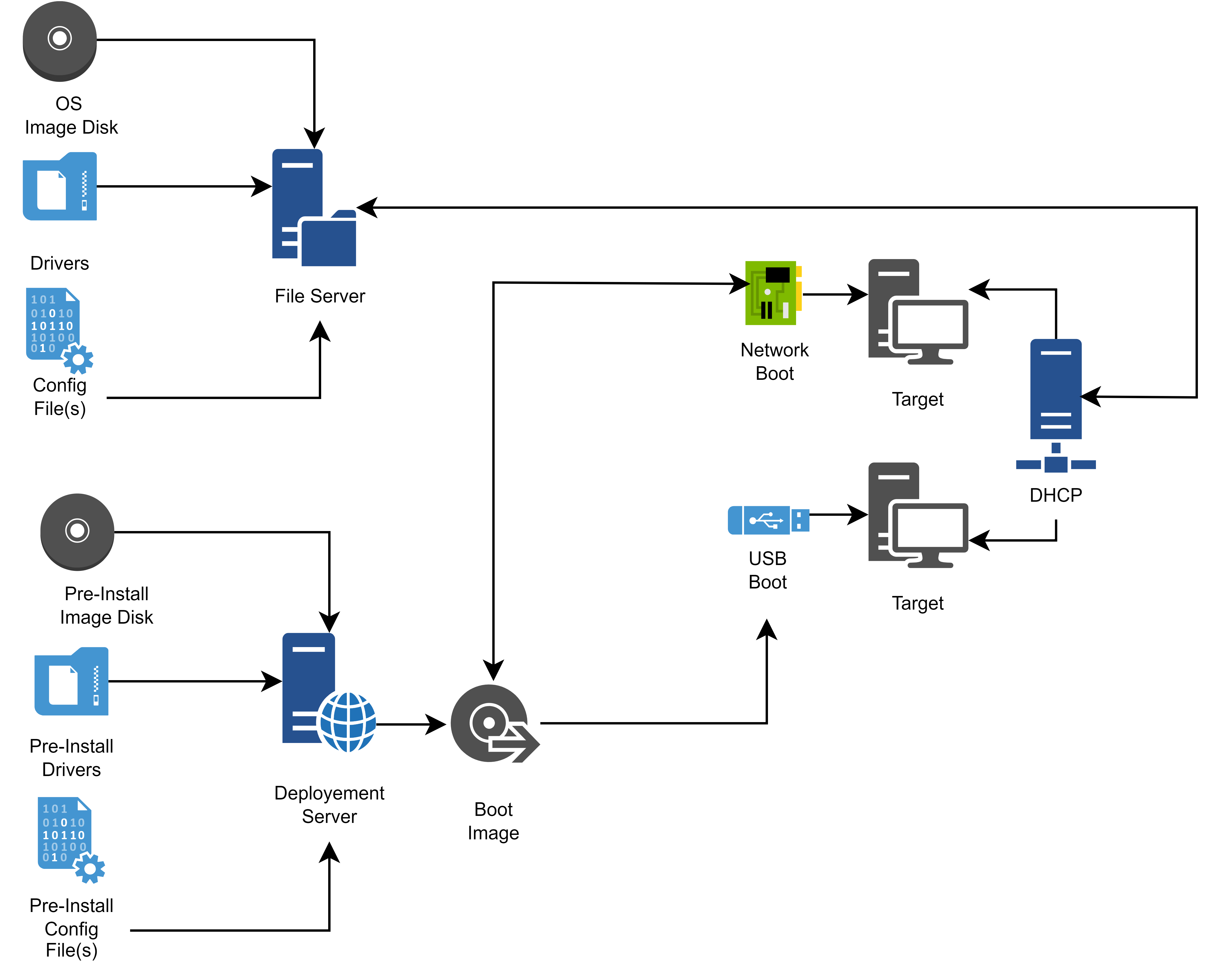
Flow diagram for a classic OS deployment¶
WADS deployment solution.
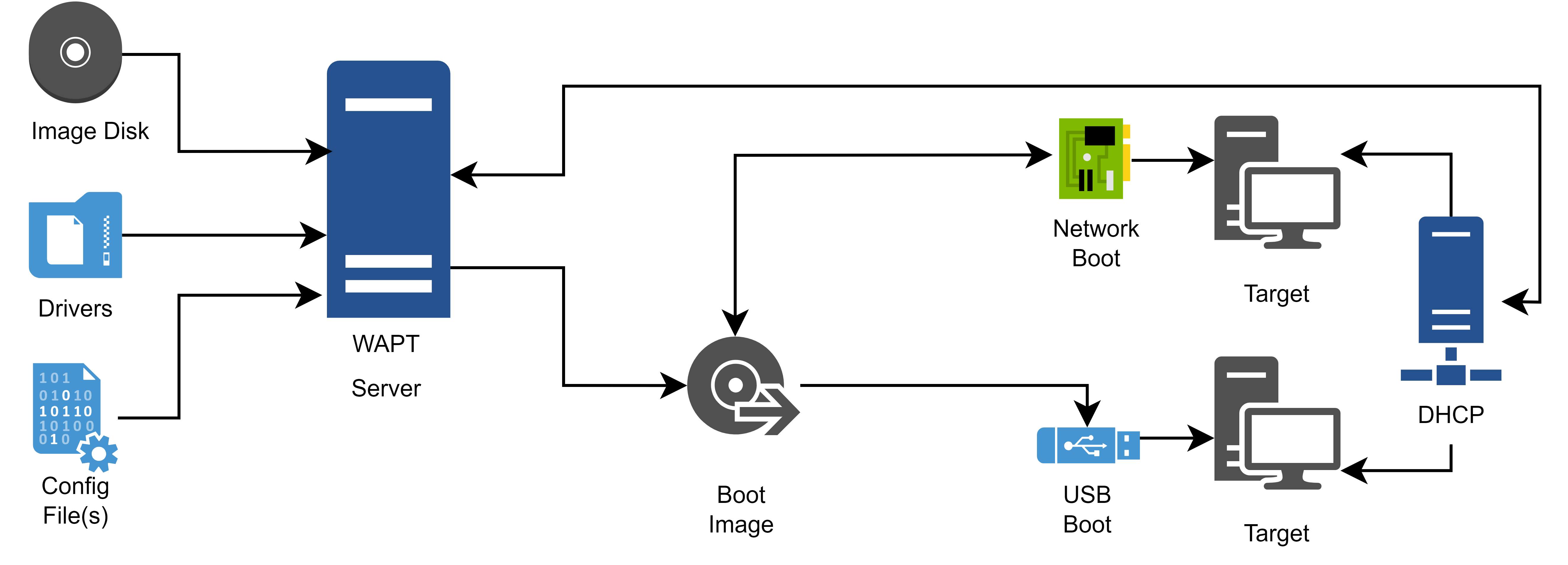
Flow diagram for a WADS deployment¶
Hint
The WADS operating mode respects the recommanded method of the OS vendor.
With WADS, all functionnalities are grouped on the same WAPT Server.
Therefore, there is no need to set up any additional infrastructure other than the WAPT Server.
7.2.2.1. Software differences¶
WADS deployment Server |
Standard MDT method |
Benefit |
|---|---|---|
Uses iPXE |
Uses CIFS file server protocol. |
No need to setup a file server and no need to open additional ports. |
No OS image configuration needed |
Requires manually editing an answer file configuration. |
Simplicity, all configurations are provided by WAPT |
Uses HTTPS to download the Windows OS image |
Uses CIFS to download the Windows OS image. |
The target hosts may be deployed over the internet using the USB stick method. |
The WADS method embeds all necessary files |
The MDT method requires assembling files from different sources. |
The deployment, the configuration and the OS updates are bundled into one WAPT software package. |
7.3. Installing and configuring TFTP and DHCP for WADS¶
7.3.1. Installing and configuring a TFTP server¶
Warning
If you have installed another tftp server on the WAPT Server, please uninstall it first.
This documentation is for WAPT 2.2.1 and higher.
Choose your distribution.
Enable and start the TFTP server.
systemctl enable wapttftpserver
systemctl start wapttftpserver
You may test that the tftp server works properly using a tftp client and test download the
snponly.efifile. If you are testing the following command on a RedHat based machine other than the waptserver, beware of the local outbound firewall that blocks outgoing tftp client requests.
cd ~
tftp srvwapt.mydomain.lan
binary
get snponly.efi
quit
ls -l snponly.efi
When installing the server, tick the WADS tftp check mark. You can re-run the installer if it was not done at that time. You can check that the service is configured and running with the command:
sc query wapttftpserver
If the server is installed but not started, you can start it with:
net start wapttftpserver
7.3.2. Installing and configuring a DHCP server¶
You can either use HTTP or TFTP (slower) to download binaries.
Warning
Downloading through HTTP implies the use of an iPXE binary (ipxe.efi or snponly.efi) that is not signed and it will NOT be POSSIBLE to enable SECURE BOOT on the client machines.
7.3.2.1. Full TFTP config¶
Here is a configuration that transfers the bootfile and binaries through TFTP. Secure Boot possible.
For example:
<!-- global options -->
next-server 192.168.1.30;
option client-architecture code 93 = unsigned integer 16;
subnet 192.168.100.0 netmask 255.255.255.0 {
filename "efi/boot/bootmgfw.efi";
}
For more information you can refer to https://ipxe.org/howto/dhcpd
For example:
dhcp-option=option:tftp-server,192.168.1.30
dhcp-boot=tag:efi,efi/boot/bootmgfw.efi
You can use the following PowerShell command line to configure booting on your network. Please adapt $waptserver_ipaddress_tftp depending on your current installation.
$waptserver_ipaddress_tftp = "192.168.154.13"
Add-DhcpServerv4Class -Name "legacy_bios" -Type Vendor -Data "PXEClient:Arch:00000"
Add-DhcpServerv4Class -Name "iPXE" -Type User -Data "iPXE"
Set-DhcpServerv4OptionValue -OptionId 66 -Value "$waptserver_ipaddress_tftp"
Add-DhcpServerv4Policy -Name "boot_uefi" -Condition AND -UserClass NE,iPXE -VendorClass NE,legacy_bios*
Set-DhcpServerv4OptionValue -PolicyName "boot_uefi" -OptionID 67 -Value "efi/boot/bootmgfw.efi"
7.3.2.2. HTTP configuration¶
The PXE booting is a two step process. First the UEFI/BIOS bootloader will download iPXE binary from the tftp server, then iPXE binary will download the iPXE script and boot binaries from http. This is why we need to have a two step PXE DCHP configuration.
For example:
<!-- global options -->
next-server 192.168.1.30;
option ipxe-url code 175 = text;
option client-architecture code 93 = unsigned integer 16;
<!-- subnet mydomain.lan netmask 255.255.255.0 -->
if option client-architecture = 00:00 {
if exists user-class and option user-class = "iPXE" {
filename "http://srvwapt.mydomain.lan/api/v3/baseipxe?uefi=false&keymap=fr";
}
else{
filename "undionly.kpxe";
}
} else {
if exists user-class and option user-class = "iPXE" {
option ipxe-url "http://srvwapt.mydomain.lan:80/";
filename "http://srvwapt.mydomain.lan/api/v3/baseipxe?keymap=fr";
}
else{
filename "snponly.efi";
}
}
For more information you can refer to https://ipxe.org/howto/dhcpd
For example:
dhcp-match=set:ipxe,175 # iPXE sends a 175 option.
dhcp-boot=tag:!ipxe,undionly.kpxe,IP_WAPTSERVER
dhcp-boot=tag:ipxe,http://srvwapt.mydomain.lan/api/v3/baseipxe?uefi=false
For example for one machine:
dhcp-match=set:ipxe,175 # iPXE sends a 175 option.
dhcp-mac=set:waptserver,MAC_ADDRESS_TARGET_COMPUTER
dhcp-boot=tag:!ipxe,undionly.kpxe,waptserver,IP_WAPTSERVER
dhcp-boot=tag:ipxe,http://srvwapt.mydomain.lan/api/v3/baseipxe?uefi=false,waptserver
You can use the following PowerShell command line to configure iPXE booting on your network. Please adapt the $url_waptserver and $waptserver_ipaddress_tftp depending on your current installation. keymap is the keyboard language.
$waptserver_ipaddress_tftp = "192.168.154.13"
$url_waptserver = "http://srvwapt.mydomain.lan"
$keymap = "fr"
Add-DhcpServerv4Class -Name "legacy_bios" -Type Vendor -Data "PXEClient:Arch:00000"
Add-DhcpServerv4Class -Name "iPXE" -Type User -Data "iPXE"
Set-DhcpServerv4OptionValue -OptionId 66 -Value "$waptserver_ipaddress_tftp"
Add-DhcpServerv4Policy -Name "wapt-ipxe-url-legacy" -Condition AND -UserClass EQ,iPXE -VendorClass EQ,legacy_bios*
Set-DhcpServerv4OptionValue -PolicyName "wapt-ipxe-url-legacy" -OptionID 67 -Value "$url_waptserver/api/v3/baseipxe?uefi=false&keymap=$keymap"
Add-DhcpServerv4Policy -Name "wapt-ipxe-url-uefi" -Condition AND -UserClass EQ,iPXE -VendorClass NE,legacy_bios*
Set-DhcpServerv4OptionValue -PolicyName "wapt-ipxe-url-uefi" -OptionID 67 -Value "$url_waptserver/api/v3/baseipxe?keymap=$keymap"
Add-DhcpServerv4Policy -Name "snponly.efi" -Condition AND -UserClass NE,iPXE -VendorClass NE,legacy_bios*
Set-DhcpServerv4OptionValue -PolicyName "snponly.efi" -OptionID 67 -Value "snponly.efi"
Add-DhcpServerv4Policy -Name "undionly.kpxe" -Condition AND -UserClass NE,iPXE -VendorClass EQ,legacy_bios*
Set-DhcpServerv4OptionValue -PolicyName "undionly.kpxe" -OptionID 67 -Value "undionly.kpxe"
For more information, you can refer to https://ipxe.org/howto/msdhcp
Attention
If your DHCP server does not allow you to set such conditions, you can run the following script that will compile customized bootfiles:
/opt/wapt/waptserver/scripts/compile_ipxe.sh
It will create 3 bootfiles that you can use on your DHCP server: ipxe_custom.efi (UEFI), snponly_custom.efi (UEFI) and undionly_custom.kpxe (Legacy).
7.4. Deploying a Windows OS via WADS¶
7.4.1. IPXE Deployment process¶
Using BIOS/UEFI:
the host makes a DHCP request to obtain an IP and the PXE configuration (TFTP server IP & iPXE file name), or
the host boots from a USB stick which embeds the PXE configuration
Using BIOS/UEFI:
the host makes a TFTP request to get iPXE and her configuration, or
the host runs the iPXE configuration from the USB stick.
Then, using iPXE, the host makes a HTTPS request to the WADS Server to obtain the BCD and the
WinPEfile.Finally, using WinPE, the host contacts the WADS Server via HTTP to obtain the OS iso file and its associated configuration files.
Warning
USB stick: secure boot possible (official winpe files used).
The ipxe file provided by WAPT does not support secure boot (ipxe file from https://ipxe.org/).
You can buy a signed ipxe file from https://2pintsoftware.com/pricing/ (iPXE Anywhere) in order to use the secure boot.
Deployment is also possible through TFTP exclusively although it is very slow.
7.4.2. Requirements before starting¶
To use WADS on your WAPT Console, you need to install a specific package on your management station.
Two packages are available, only one is needed. Choose according to your needs:
This package integrates the minimal requirements for creating a WinPE file.
This package installs Windows ADK, all the tools to create and modify WinPE.
As of 2024-10-28, the user account using the WADS Console MUST have Local Administrator rights in the WAPT Access Control Lists.
Signing WADS with your certificate:
Go to the .
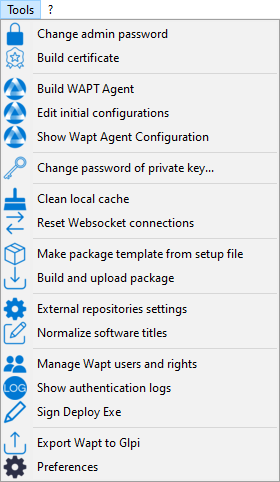
Click on the Sign button:
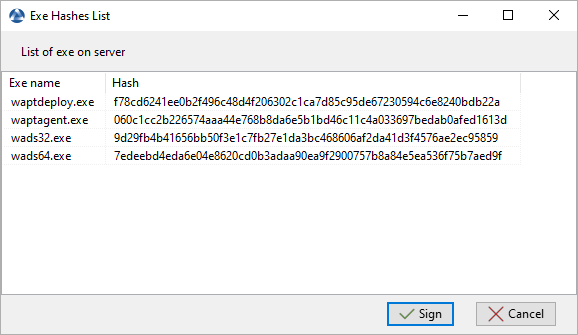
Go to the OS Deploy tab:
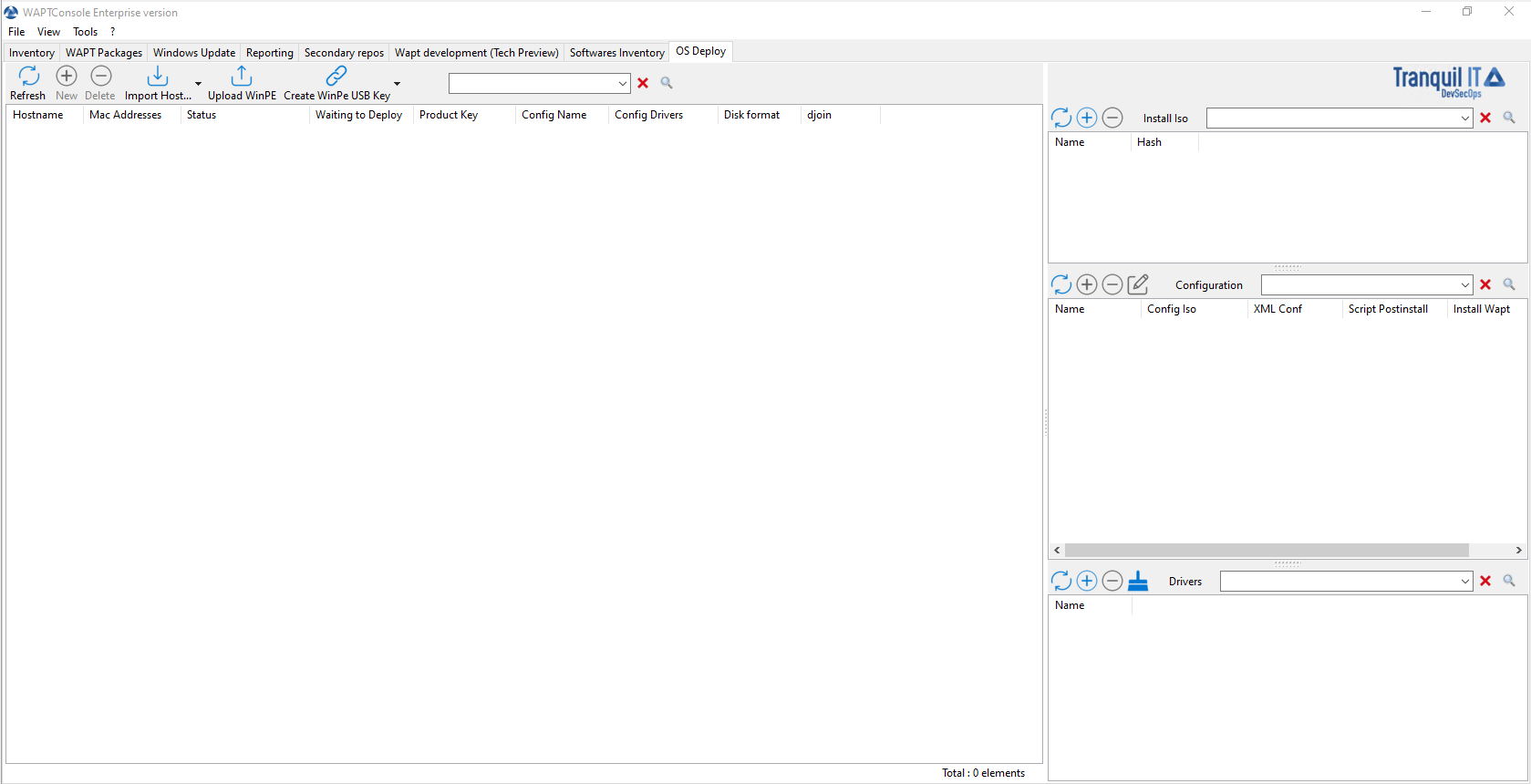
Main window of the WADS Console¶
7.4.3. Adding the WinPE files¶
WinPE is a minimal operating system used to install, deploy, and repair Windows.
On WADS, WinPE is used to bootstrap the deployment of Windows.
If no WinPE file exists, then this pop-up will appear.
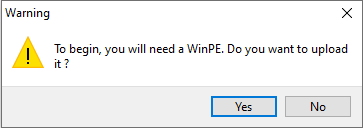
Then click on Upload WinPE.
Choose the keyboard layout. This step is important because you will type in the hostname in WinPE using the keyboard layout chosen with this step.
Select the certificate with which to sign the USB stick files.
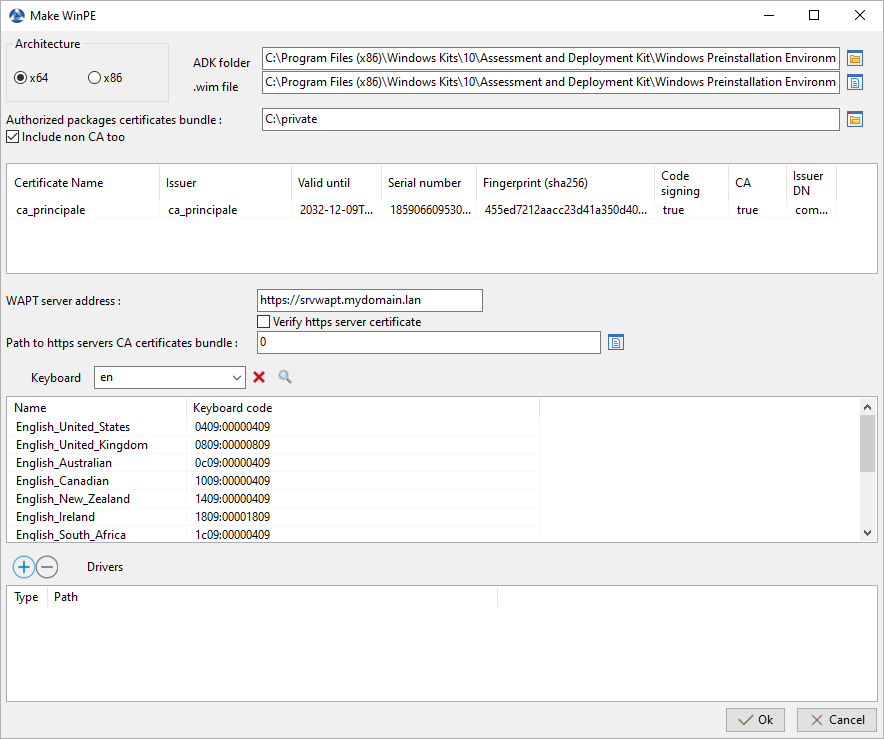
If needed, please add network drivers in order to boot with PXE
Wait while the
WinPEfile uploads onto the WAPT administration computer.

Wait while the
WinPEfile uploads to the WADS Server.
The WinPE file has been successfully uploaded to the WADS Server.
Hint
After each upgrade, you will have to re-sign the WinPE file. Do not forget to keep up-to-date network drivers if needed.
7.4.4. Adding the Operating System ISO¶
The next step is to add the Operating System .iso file to use for deploying Windows.
Use the latest official Windows release from Microsoft as the .iso file.

ISO section of the WADS Console¶
In the Install ISO section in the main WADS Console, click on the + button to upload the selected .iso file.
Select the .iso file and give it a name.
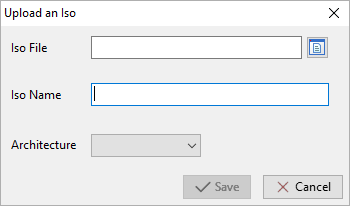
Dialog box for selecting the ISO file to upload to the WADS Server¶
When uploaded, the .iso file is signed with the selected certificate.
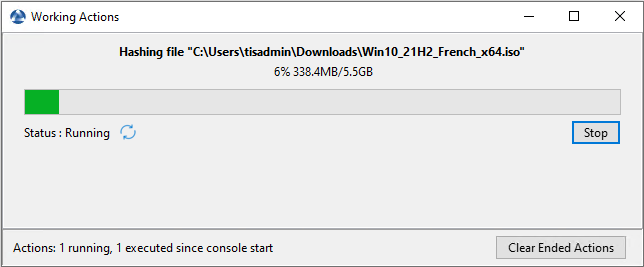
Dialog box informing of the signing progression of the ISO file in the WADS Console¶
After the signing step has successfully completed, the .iso file is uploaded to the WADS Server.

Dialog box informing of the uploading progession of the ISO file in the WADS Console¶
After the uploading step has successfully completed, the .iso file appears in the Install iso section in the main WADS Console.

Hint
It is possible to upload several .iso versions of Windows for different use cases.
7.4.5. Adding the Configuration answer file¶
The next step is to add the Configuration answer file that will be used to configure the deployment of the Windows Operating System.
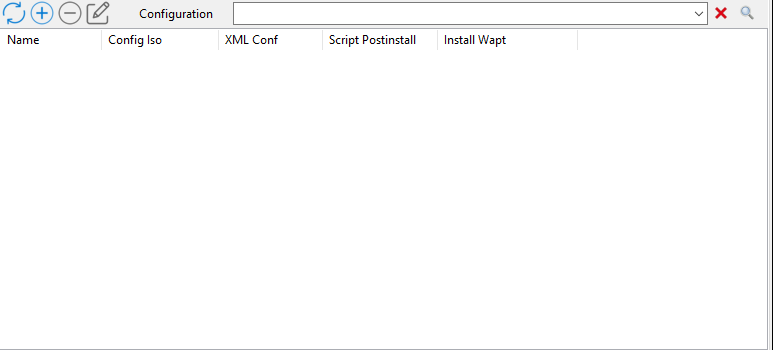
Answer file section of the WADS Console¶
In the Configuration section click on the + button to configure the answer file.
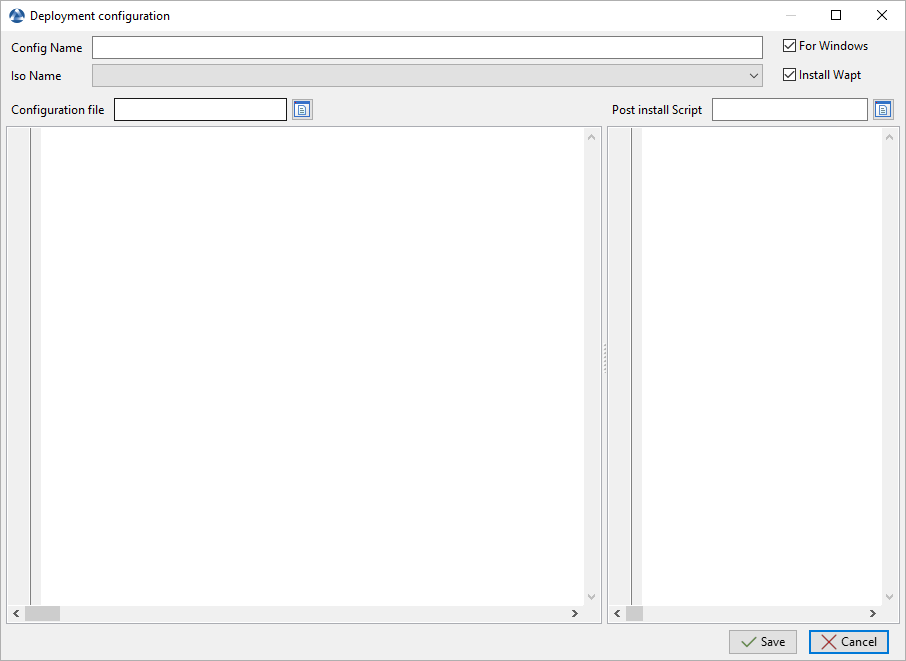
Window for creating the answer configuration file in the WADS Console¶
Options |
Description |
|---|---|
Config Name |
Defines the name of the XML answer file. |
ISO Name |
Defines the .iso file to associate to the XML answer file. |
For Windows |
Defines whether you install a Windows OS or Linux if unchecked. |
Install Wapt |
Defines whether to install the WAPT agent after the installation of the Operating System. |
Configuration file |
Defines the XML answer files template to use for Windows or the configuration file for Linux. |
Post install Script |
Defines a .bat post-install script to be run after the installation of the Operating System. |
Insert into the Config Name field the name of the answer file.
Select with the Iso Name dropdown the ISO file to association to the deployment configuration.
Check or uncheck the Install WAPT checkbox to install the WAPT Agent by default.
Check or uncheck the For Windows checkbox to install a Windows OS.
Select the answer file template to associate to the deployment configuration with the Configuration File field. If the OS is not Windows, select the configuration file for Linux.
If necessary, set the post-install script in Post install Script, for example:
"C:\Program Files (x86)\wapt\wapt-get.exe" install tis-firefox-esr
Click on the Save button to create the answer file.
When done, the configuration appears in the Configuration section.

Answer file added to the WADS Server in the WADS Console¶
Hint
It is possible to create several answer file configurations for different versions of Windows / Linux and for different use cases.
7.4.6. Joining the host to an Active Directory domain¶
You can use your own answer file with WADS but by default, WADS integrate 2 types of answer files for Windows:
Offline to join a computer with the DirectAccess Offline Domain Join (Djoin) method.
Online to join a computer on the AD.
Update this part with your join service account, you can give a specific OU if you want. If not, just delete the line MachineObjectOU.
<Identification>
<Credentials>
<Domain>mydomain.lan</Domain>
<Password>password</Password>
<Username>wadsjoin</Username>
</Credentials>
<JoinDomain>mydomain.lan</JoinDomain>
<MachineObjectOU>OU=MyOu,OU=MyParentOu,DC=MyDomain,DC=lan</MachineObjectOU>
</Identification>
The offline method uses the Djoin method.
Right-click on the host to open the menu list.
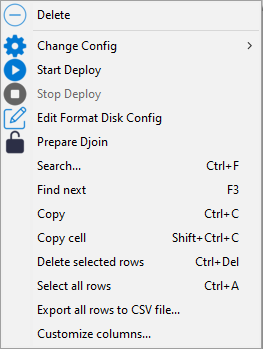
Click on Prepare Djoin.
Select the OU to which to attach the host (or define it manually) and click on Save.
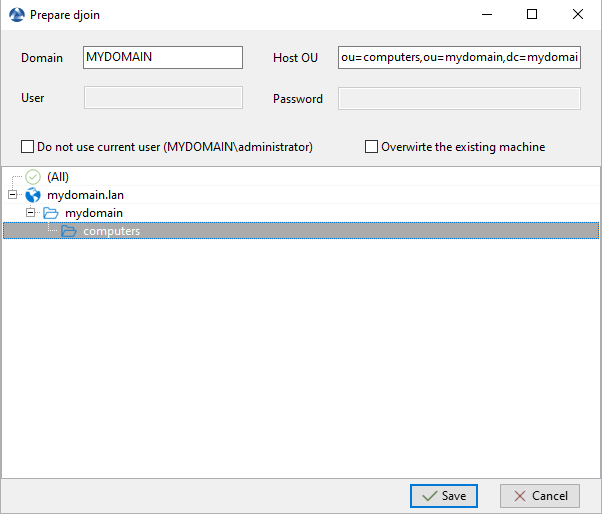
Selecting the Organizational Unit to which to automatically attach the re-imaged host¶
You can check Do not use current user if your current user can not or must not join a computer to the domain. If checked, you have to give manually Domain, Host OU, User (just the sAMAccountName, not the UPN nor the DOMAINuser) and password.
You can check Overwrite the existing machine in order to join anew a computer.
The
Djoinfile is ready to be used to join the host as a member to the Active Directory domain.
7.4.7. Adding drivers¶
The next step is to add driver bundles that will be used during the deployment of the Windows Operating System.

Drivers section of the WADS Console¶
In the Drivers section click on the + button to add a driver pack to the WADS Server.
This window allows you to upload the driver bundles to associate to the Windows deployment.
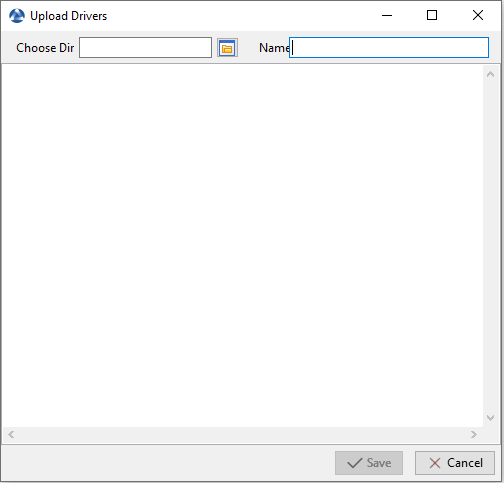
Window for creating the driver bundles in the WADS Console¶
Options |
Description |
|---|---|
Choose Dir |
Defines the path to the folder containing the driver bundles. |
Name |
Defines the name of the driver bundle. |
Click on the Save button, the uploading of the driver bundles starts.
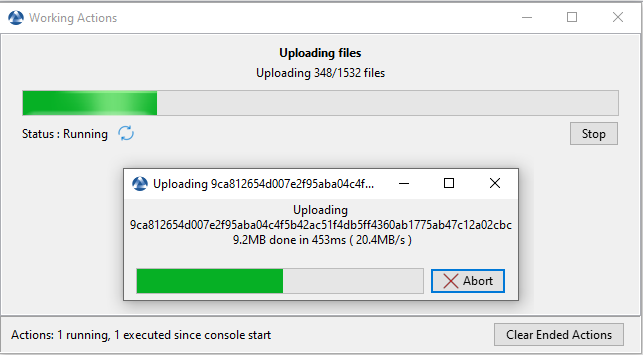
Dialog box informing the uploading progression of the driver bundles in the WAPT Console¶
When uploaded, the drivers pack appears in the Drivers section of the WADS Console.

The drivers pack has been uploaded to the WADS Server¶
It is possible to create several driver packs for different versions of Windows and for different use cases.
It is possible to use the .cab files from OEM.
It is also possibe to export the drivers from an existing well functioning host using a Powershell command.
Export-WindowsDriver -Online -Destination D:\Drivers
7.4.8. Booting the host to re-image with WADS¶
WADS allows 2 methods boot the host to re-image:
7.4.8.1. Booting the host with a USB stick¶
Note
The USB key used MUST be FAT32 formatted and empty.
Insert the USB stick in the WAPT adminsitration workstation and click on the Create WinPE USB Key button to start the process.
Choose the keyboard layout. This step is important because you will type in the hostname in WinPE using the keyboard layout chosen with this step.
Select the certificate with which to sign the USB stick files

Click on the Upload WinPE to format the USB stick and copy the WinPE file.
Boot to the computer’s boot menu using the USB stick option and go to the run the deployment step.
Note
You can Export to zip when you create a WinPE USB Key if you can not use a USB key and then burn it onto a CD / DVD instead.
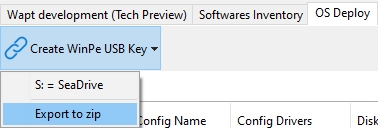
WADS button to select export to zip¶
7.4.8.2. Booting the host with the network¶
Booting from the LAN requires:
A properly working TFTP server;
A properly working DHCP server;
Having port 69 open on the WAPT Server for inbound traffic, and having tftp conntrack enabled on intermediate firewalls if you have firewalls between the server and the client computer.
Boot to the computer’s boot menu using the LAN option and go to the run the deployment step.
7.4.9. Deploying the Windows image¶
There are 3 choices when booting with iPXE:
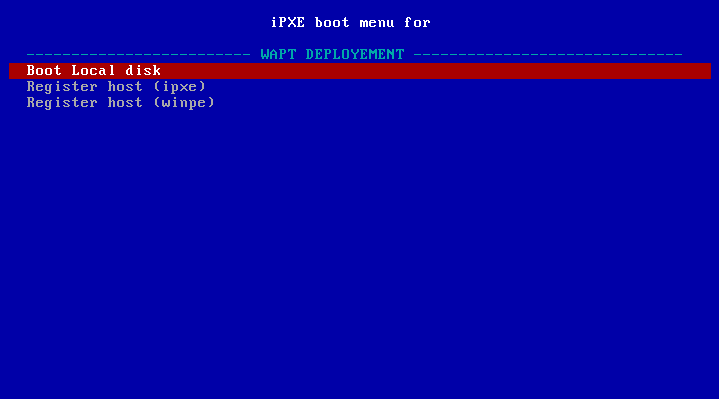
iPXE boot menu window¶
Boot Local disk for starting normally from local storage;
Register host (ipxe) to register the host with the WADS Server using the iPXE method;
Register host (winpe) to register the host with the WADS Server using the WinPE method.
If choosing Register host (ipxe), define a hostname.

Text terminal window requesting a hostname when registering using the iPXE method¶
Warning
The keybord is qwerty
Refresh the WADS Console with F5, the host appears in the OS Deploy tab.

Host waiting to be deployed¶
At this time, the Waiting to Deploy status of the host is False.
Right click on the host to open the menu list.

Go to and select a XML answer file.
Click on Start Deploy, the Waiting to Deploy status of the host switches to True.

Reboot the host to the same boot option as before (USB or LAN), Windows will start to install.
When the installation has completed, the OS Deploy tab, the status switches to Done.
If choosing Register host (winpe), define a hostname:

Text terminal window requesting a hostname when registering using the WinPE method¶
The keybord is in the same layout as the one set during the WinPE step of this documentation.
Refresh the WADS Console with F5, the host appears in the OS Deploy tab.

Host waiting to be deployed¶
At this time, the Waiting to Deploy status of the host is False.
Right click on the host to open the menu list.

Go to and select a XML answer file.
Click on Start Deploy, the Waiting to Deploy status of the host switches to True.

Reboot the host to the same boot option as before (USB or LAN), Windows will start to install.
When the installation has completed, the OS Deploy tab, the status switches to Done.
7.4.10. Format host disk¶
When your host is ready to be redeployed, if necessary, you can format its disk using the UEFI or the Legacy method.
To do so, right-click on host then Edit Format Disk Config.
Then you can choose either the UEFI or the Legacy script and customize the disk format configuration. Here is an example with the Legacy script:

